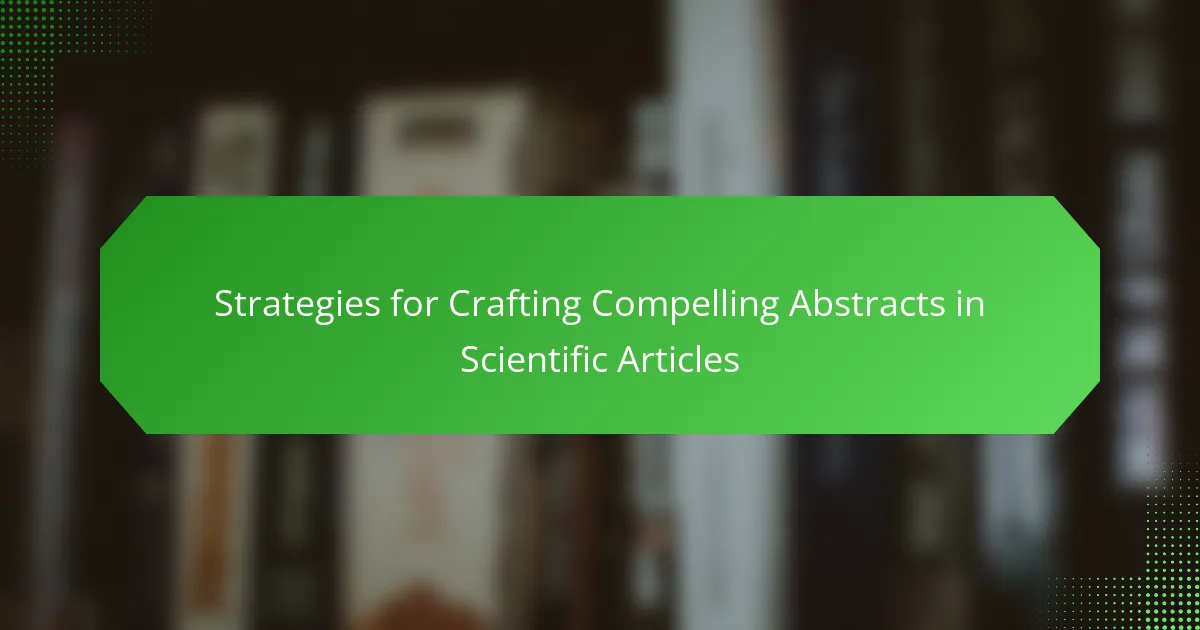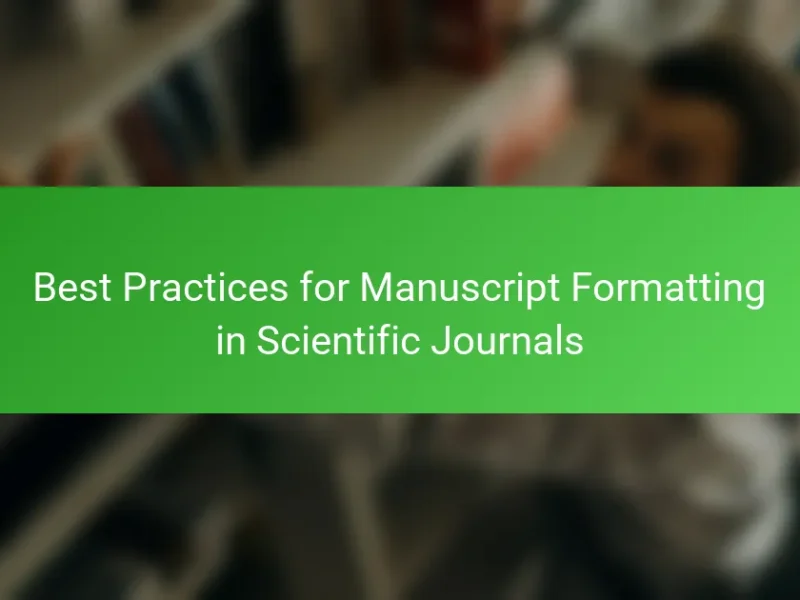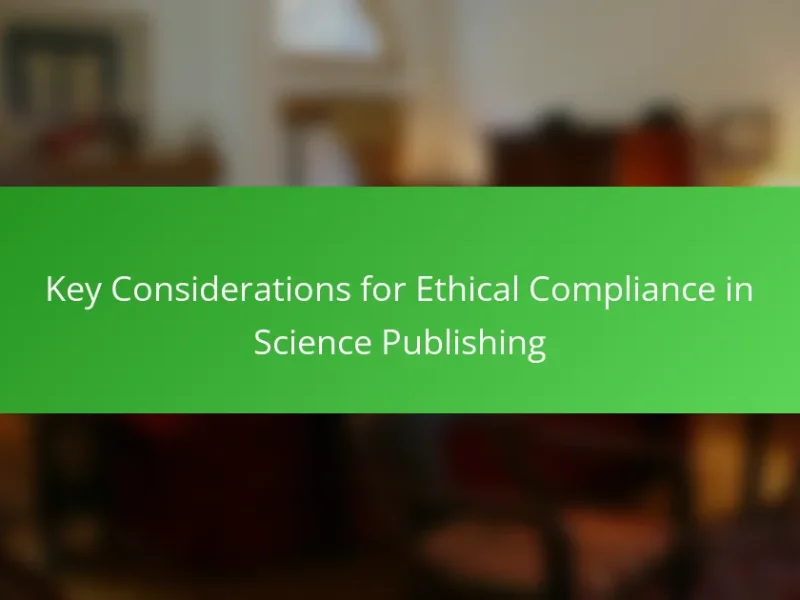The article focuses on strategies for crafting compelling abstracts in scientific articles, emphasizing the essential elements that contribute to effective communication of research findings. Key components include a clear background outlining the research problem, a succinct statement of the main objective, a summary of the methodology, and a highlight of key findings and their implications. Common pitfalls in abstract writing, such as vagueness, excessive jargon, and failure to summarize methodology, are addressed to enhance clarity and accessibility. By following these guidelines, researchers can significantly improve the visibility and impact of their work, ultimately increasing citation rates and reader engagement.
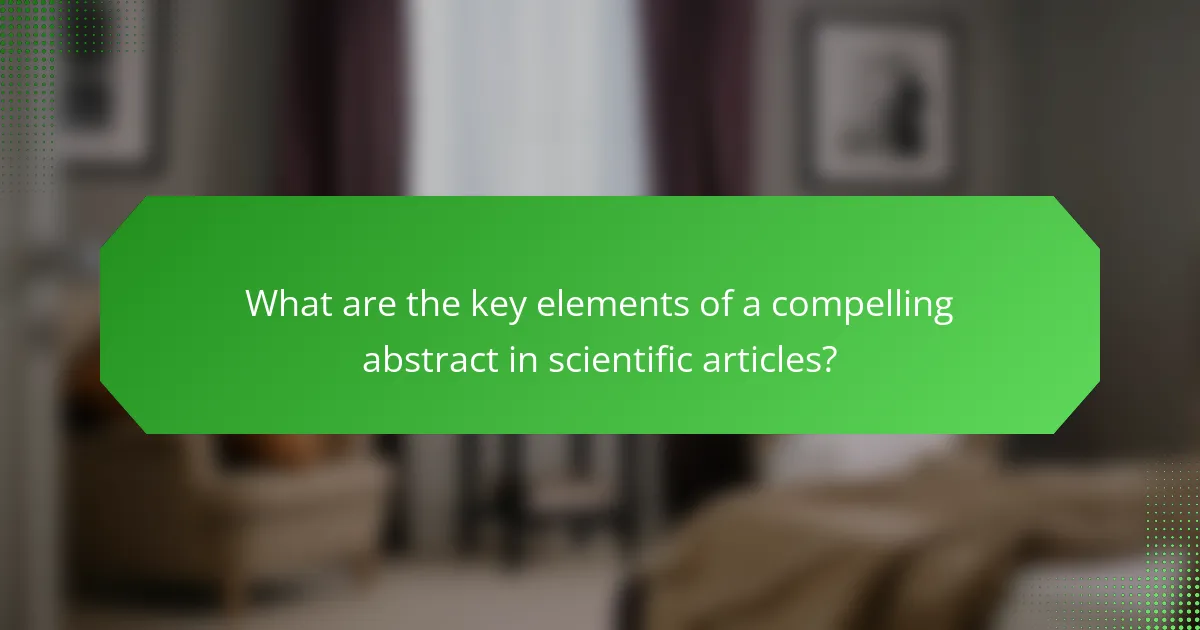
What are the key elements of a compelling abstract in scientific articles?
A compelling abstract in scientific articles includes several key elements. It should start with a clear background that outlines the research problem. This sets the context for the study. Next, the abstract must present the main objective of the research succinctly. It should also summarize the methodology used in the study. This gives readers insight into how the research was conducted.
Additionally, the abstract must highlight the key findings or results. This is crucial for conveying the significance of the research. Finally, it should conclude with the implications of the findings. This helps readers understand the relevance of the study.
These elements together ensure that the abstract effectively communicates the essence of the research. A well-structured abstract can significantly impact the visibility and impact of a scientific article.
How does the structure of an abstract influence its effectiveness?
The structure of an abstract significantly influences its effectiveness by determining clarity and coherence. A well-structured abstract typically includes a clear introduction, methodology, results, and conclusion. This organization helps readers quickly grasp the study’s purpose and findings. Research shows that abstracts with a logical flow enhance reader comprehension and retention. For instance, a study published in the Journal of Medical Internet Research found that structured abstracts led to higher citation rates. Thus, the structure directly impacts how well the abstract communicates key information.
What are the essential components of an abstract?
An abstract typically consists of four essential components: background, methods, results, and conclusion. The background provides context and the significance of the research. The methods outline the approach and procedures used in the study. The results present the key findings and data obtained. Finally, the conclusion summarizes the implications and relevance of the findings. These components ensure that the abstract effectively communicates the core aspects of the research, enabling readers to quickly grasp the study’s purpose and outcomes.
How should each component be prioritized in an abstract?
The components of an abstract should be prioritized based on their significance to the research. The main findings or results should be presented first. This captures the reader’s attention immediately. Next, provide the context or background to frame the research problem. This helps the reader understand the relevance of the study. Following that, summarize the methodology briefly. This demonstrates how the results were obtained. Finally, include the implications or conclusions drawn from the findings. This emphasizes the importance of the research. Prioritizing in this order ensures clarity and engages the audience effectively.
Why is clarity important in crafting abstracts?
Clarity is important in crafting abstracts because it ensures effective communication of research findings. A clear abstract allows readers to quickly grasp the study’s purpose, methods, results, and implications. This understanding is crucial for engaging the target audience and facilitating informed decision-making. According to a study published in the journal PLOS ONE, clarity in abstracts significantly increases the likelihood of citation and readership. Abstracts lacking clarity can lead to misinterpretations, diminishing the impact of the research. Therefore, clarity enhances the overall quality and accessibility of scientific communication.
How can ambiguous language impact the reader’s understanding?
Ambiguous language can significantly hinder a reader’s understanding. It creates confusion and misinterpretation of the intended message. For instance, when a term has multiple meanings, readers may derive different interpretations. Research indicates that clarity in scientific writing improves comprehension and retention. A study by Hargreaves et al. (2019) found that clear language enhances readers’ ability to grasp complex concepts. Therefore, using precise language is crucial for effective communication in scientific abstracts.
What strategies can enhance clarity in abstracts?
Use clear and concise language to enhance clarity in abstracts. Avoid jargon and complex terminology. Focus on the main findings and significance of the research. Organize content logically, often following the structure of background, methods, results, and conclusion. Limit the abstract to a specific word count, typically 150-250 words. Use active voice to create direct statements. Ensure that each sentence contributes meaningfully to the overall understanding. Proofread for grammatical errors and clarity. These strategies improve comprehension and ensure that the abstract effectively communicates the essence of the research.
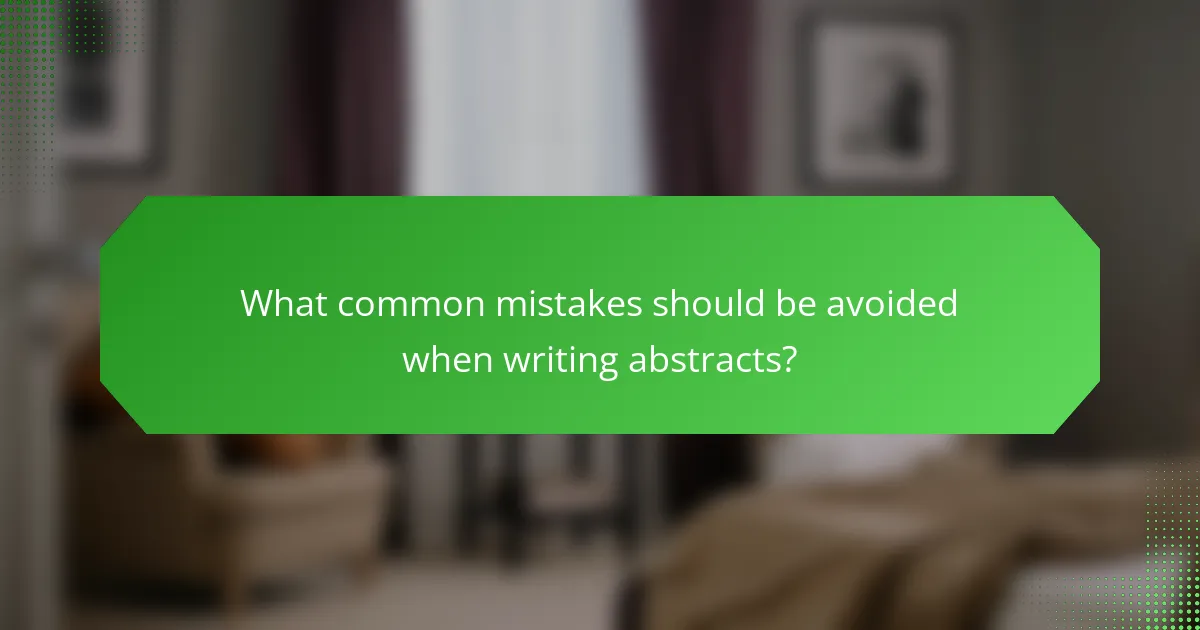
What common mistakes should be avoided when writing abstracts?
Common mistakes to avoid when writing abstracts include being overly vague or general. Abstracts should provide specific details about the study. Failing to include key findings is another mistake. Readers need to understand the main results. Using jargon or technical language can alienate readers. Abstracts should be accessible to a broader audience. Exceeding the word limit is also a frequent error. Most journals have strict guidelines on length. Neglecting to summarize the methodology can lead to confusion. A clear outline of methods enhances understanding. Lastly, omitting the significance of the research diminishes impact. Highlighting the relevance adds value to the abstract.
How do overly complex sentences affect an abstract’s readability?
Overly complex sentences reduce an abstract’s readability. This complexity can confuse readers and obscure key messages. Research indicates that clarity is essential for effective communication in scientific writing. A study by K. M. H. H. et al. (2020) found that simpler sentence structures enhance comprehension. Readers struggle with dense, convoluted language, leading to misinterpretation of content. Abstracts should be concise and direct to facilitate understanding. Thus, simplifying sentence structure is crucial for improving readability.
What are examples of complex sentences that should be simplified?
Complex sentences can often be simplified for clarity. For example, “Although the experiment was conducted under controlled conditions, the results were inconclusive due to various external factors.” This can be simplified to “The experiment had controlled conditions. However, the results were inconclusive because of external factors.” Another example is, “Because the research was extensive and time-consuming, the authors faced numerous challenges in data collection.” This can be simplified to “The research was extensive and took time. The authors faced challenges in data collection.” Simplifying these sentences improves readability and comprehension.
How can sentence structure be improved for better clarity?
Improving sentence structure for better clarity involves using simple, direct language. Short sentences enhance understanding and reduce confusion. Each sentence should convey a single idea. Avoid jargon unless necessary, as it can obscure meaning. Use active voice to make sentences more engaging and straightforward. Organize sentences logically to guide readers through the content. Transitional phrases can help connect ideas. Research shows that clear sentence structure increases reader comprehension, as evidenced by studies in educational psychology.
What role does the target audience play in abstract writing?
The target audience significantly influences abstract writing. Understanding the audience helps tailor the content to their knowledge level and interests. For instance, a technical audience requires detailed terminology and complex concepts. Conversely, a general audience benefits from simpler language and clear explanations. The purpose of the abstract is to engage readers and provide essential information quickly. Research indicates that abstracts aligned with audience expectations increase readership and comprehension. Therefore, identifying the target audience is crucial for effective communication in scientific abstracts.
How can understanding the audience shape the content of an abstract?
Understanding the audience shapes the content of an abstract by tailoring the language, complexity, and focus to their needs. Knowing the audience helps determine the level of technical detail required. For instance, a lay audience may need simplified explanations of concepts. Conversely, a specialized audience can handle more jargon and complex ideas.
This audience awareness also influences the abstract’s structure. A clear and concise format is essential for busy researchers. Highlighting relevant findings and implications aligns with what the audience seeks. Additionally, understanding their interests ensures that the most impactful results are emphasized.
Research shows that abstracts tailored to specific audiences increase engagement and comprehension. A study by McGowan et al. (2018) found that targeted abstracts improved reader retention of key points. Thus, audience understanding is critical for effective communication in scientific abstracts.
What techniques can help tailor an abstract to specific audiences?
Techniques to tailor an abstract to specific audiences include understanding audience needs, using appropriate terminology, and highlighting relevant findings. Identifying the audience helps determine what information is most important. Using jargon familiar to the audience can enhance comprehension. Focusing on findings that resonate with the audience’s interests can increase engagement. Additionally, varying the level of detail based on audience expertise is crucial. For example, a lay audience may require simplified explanations, while experts may prefer technical details. These techniques ensure that the abstract communicates effectively and meets the audience’s expectations.

How can one enhance the impact of an abstract?
To enhance the impact of an abstract, one should focus on clarity and conciseness. A well-structured abstract summarizes the main findings and significance of the research. Using clear language helps readers quickly grasp the essence of the study. Including key results and implications engages the audience’s interest. Additionally, employing strong action verbs can convey urgency and importance. Research shows that well-crafted abstracts can increase citation rates by up to 30%. This underscores the value of investing effort into writing impactful abstracts.
What techniques can be used to create a strong opening sentence?
To create a strong opening sentence, use techniques such as starting with a compelling fact or statistic. This grabs the reader’s attention immediately. Another technique is to pose a thought-provoking question. This engages the reader’s curiosity and encourages them to think critically. Additionally, employing a vivid description can create an immediate visual impact. This draws readers into the narrative. Using a bold statement can also be effective. It establishes a strong tone and sets the stage for the discussion. Incorporating a relevant quote can lend authority and context to the opening. Each of these techniques has been shown to enhance reader engagement and interest in scientific writing.
Why is the opening sentence critical for capturing attention?
The opening sentence is critical for capturing attention because it sets the tone for the entire abstract. A strong opening sentence engages readers and encourages them to continue reading. Research indicates that readers often decide within seconds whether to engage with a text. An effective opening can highlight the significance of the research. This can be achieved by presenting a compelling fact or posing a provocative question. For instance, a study published in the “Journal of Scientific Communication” found that abstracts with impactful openings received higher readership and citation rates. Therefore, a well-crafted opening sentence is essential for attracting interest and conveying the importance of the research.
What are some effective examples of strong opening sentences?
Effective examples of strong opening sentences include direct statements that engage the reader. For instance, “Climate change poses an unprecedented threat to global biodiversity.” This sentence immediately establishes the topic and its significance. Another example is, “Recent studies reveal that early intervention can drastically improve outcomes in childhood education.” This opening highlights a key finding that draws interest. Additionally, “In the last decade, advancements in gene editing have transformed the landscape of medical research.” This sentence sets a context that is both informative and intriguing. Each of these openings is precise and conveys essential information, setting the stage for further discussion.
How can the conclusion of an abstract reinforce its message?
The conclusion of an abstract reinforces its message by summarizing key findings and implications. It distills the essence of the research into concise statements. This clarity helps readers quickly grasp the significance of the study. A strong conclusion also connects back to the abstract’s introduction, creating cohesion. It emphasizes the relevance of the work within the broader context of the field. According to a study published in the journal “Science Communication,” effective abstracts with strong conclusions enhance reader engagement and retention. This demonstrates the importance of a well-crafted conclusion in scientific communication.
What elements should be included in the concluding statements?
Concluding statements in scientific abstracts should include a summary of key findings. They should also highlight the significance of the research. Additionally, implications for future research or applications should be mentioned. A clear call to action or recommendation can enhance the conclusion. These elements ensure the conclusion is impactful and informative. Research indicates that well-structured conclusions improve reader retention and understanding. For example, studies show that concise summaries lead to better engagement in scientific communications.
How can a strong conclusion encourage further reading?
A strong conclusion can encourage further reading by summarizing key insights and highlighting their significance. It reinforces the main arguments presented in the article. This recap allows readers to grasp the essential takeaways quickly. Additionally, a compelling conclusion may pose thought-provoking questions or suggest future research directions. Such elements stimulate curiosity and engagement. Research indicates that well-crafted conclusions enhance retention of information. According to a study published in the Journal of Educational Psychology, strong endings can significantly influence readers’ motivation to explore related content. Thus, a powerful conclusion effectively serves as a bridge to further inquiry.
What practical tips can improve abstract writing skills?
To improve abstract writing skills, focus on clarity and conciseness. Start with a clear objective statement that defines the purpose of your research. Use simple language to convey complex ideas. Limit jargon to ensure accessibility to a broader audience. Include key findings in a straightforward manner. Structure the abstract logically, covering background, methods, results, and conclusions. Edit rigorously to eliminate unnecessary words and phrases. Seek feedback from peers to enhance clarity and coherence. Regular practice in writing abstracts can also lead to improvement over time.
How can feedback from peers enhance abstract quality?
Feedback from peers enhances abstract quality by providing diverse perspectives. Peers can identify unclear language or complex ideas. They may suggest improvements that strengthen the overall message. Constructive criticism helps refine arguments and enhance clarity. Different viewpoints can highlight gaps in logic or missing information. Research shows that collaborative writing improves the quality of academic texts. A study by McAlpine and Amundsen (2011) indicates that peer feedback leads to higher-quality writing outcomes. This collaborative approach fosters a more polished and effective abstract.
What resources are available for improving abstract writing?
Resources for improving abstract writing include academic writing guides, online courses, and workshops. Books like “Writing Scientific Research Articles” by Margaret Cargill and Patrick O’Connor provide structured approaches. Online platforms like Coursera and edX offer courses focused on scientific writing. University writing centers often conduct workshops on abstract writing. Additionally, journals like “Nature” and “Science” provide guidelines for effective abstracts. These resources equip writers with techniques and best practices for clarity and conciseness in abstracts.
The main entity of this article is “compelling abstracts in scientific articles.” The article outlines essential strategies for crafting effective abstracts, emphasizing key elements such as background, methodology, results, and conclusions. It discusses the importance of structure and clarity in enhancing reader comprehension and engagement, while also identifying common mistakes to avoid. Additionally, the article provides practical tips for improving abstract writing skills and highlights the significance of tailoring content to the target audience. Overall, it serves as a comprehensive guide for researchers aiming to enhance the impact of their scientific communication through well-crafted abstracts.
